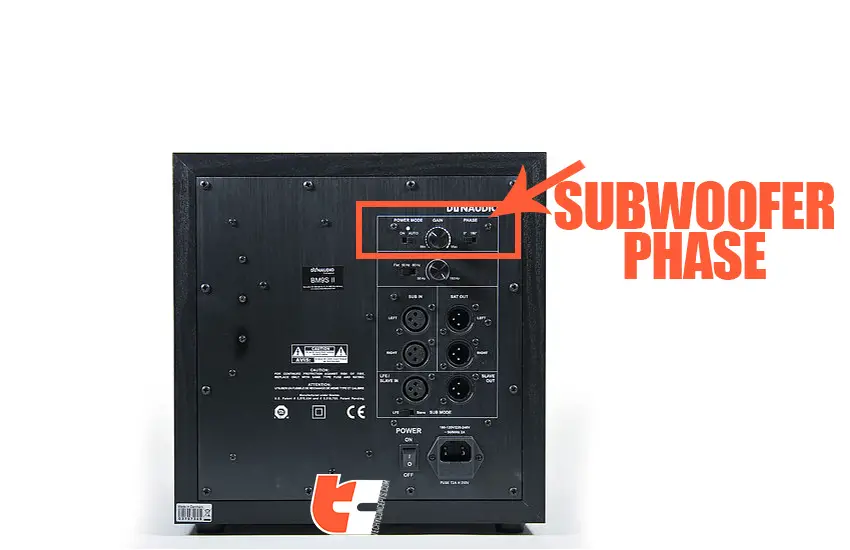Subwoofers deliver exceptional audio, which is why they are the perfect companion to have during car rides or for a captivating home theater experience.
While setting up a subwoofer for the first time, you might be wondering, “Should the subwoofer phase be normal or reverse?”
Well, when it comes to a home theater, also in the case of a single subwoofer, the best choice is to set it in the normal phase. However, when dealing with a home theater equipped with two or more subwoofers, it can get tricky to decide which phase to set it at.
But don’t worry, we’re here for you. In the rest of the article, we will give you an in-depth guide of all the aspects tied to subwoofer phase settings. Let’s dive in!

Setting and Testing Subwoofer Phases
When it comes to finetuning your subwoofers, you’ve got a couple of routes to explore when setting up the phase.
First off, there’s the “normal phase,” set at 0, and then there’s the “reverse phase,” clocking in at 180. Normal keeps everything as is, while the reverse flips the polarity around.
How do you nail the subwoofer phase? It’s all about personal taste and what your ears pick up. Most folks tend to give the phase knob a twist to turn up the volume a bit. But let’s be real, finding that sweet spot might require some experimentation.
Now, if you don’t have high-tech sound measuring equipment lying around, no worries. Just trust your own hearing to guide you towards the loudest setting. Well, come on, when you’re adding a sub, you’re looking for that chest-thumping bass, right? So go on, turn the dial up and trust your eardrums for a hearing test.
However, it’s not a bad idea to have some tools at your disposal. USB measurement microphones, for example, can be your sidekick in this audio adventure, helping you fine-tune those sound frequencies just the way you like ’em.
Now, let me break down the steps for tweaking that subwoofer phase:
Feeling conventional? Set the phase switch to 0 degree for keeping things ‘normal’.
Feeling a bit adventurous? Flip it to 180 degree for a reverse experience.
Time for the true test – toggle between the settings, move around the room, and find where that bass hits the right spot. Proper placement is key for that ear-pleasing bass boost.
But wait, there’s more to getting your subwoofer game on point than just fiddling with the phase knob. You’ve got to consider where you’re placing your subwoofer – location matters for perfect sound quality. Oh, and don’t forget, your sub and speakers need to team up to deliver that ultimate bass performance.

Should Subwoofers Be in Normal Phase or Reverse?
Alright, let’s break down the subwoofer phase – it’s basically how audio waves sync up. You’ve got these waves moving around, creating highs and lows in sound. When two waves sync timing, their highs and lows match up, and they’re what we call “in phase.”
Now, usually, it’s a safe call to set your subwoofer phase to normal. That means it’s grooving in sync with your main speakers. But, remember – room setup and speaker location also play vital roles too. Play around with both settings to figure out what vibes best in your specific setup.
When you’re getting things sorted during setup and testing, stick with the normal subwoofer phase. If the sound isn’t hitting right, try switching to reverse phase and see if you’ve got the perfect loudness level.
At the end of the day, it really depends on you, your preferences, your likings and your taste in music.
Does Subwoofer Phase Make a Difference?
Definitely yes! The phase of your subwoofer holds the potential to significantly impact the overall sound quality of your audio setup.
Ensuring the proper alignment between your subwoofer and main speakers is like hitting the sweet spot – it allows the sound waves from both sources to support each other like good friends, preventing any chance of them canceling each other out. The result? A well-rounded and harmonious bass response that improves the overall audio quality.
How To Understand If My Subwoofer is Out of Phase?
To determine if your subwoofer is correctly phased, you can follow these steps one by one:
Step 1: Perform a Listening Test
Begin by playing music or content that features noticeable bass frequencies. Pay close attention to the bass response. If it’s coming across as tight, punchy, and seamlessly melded with your main speakers, chances are your subwoofer is operating in phase.
Step 2: Switch Phases
Some subwoofers come equipped with a phase switch, allowing you to alternate between 0° (normal) and 180° (inverted) phase settings. Kick things off by setting the phase to 0° (normal) and assess the bass response. Then, switch to 180° (inverted) and give it another listen. Opt for the setting that delivers great bass integration and fullness.
Step 3: Bass Cancellation
If you notice a drop in the bass sound when your subwoofer plays with the main speakers, it might mean the phases aren’t aligned correctly. If that’s the case, try flipping the subwoofer phase to the inverted setting and observe if it rectifies the bass response.
Step 4: Use Measurement Tools
Utilizing audio measurement tools like a sound level meter or a spectrum analyzer app can provide valuable insights into the bass response. Place the microphone near your listening spot and study the frequency response. If you spot any spikes or dips in the bass frequencies, experimenting with the phase settings might help in getting rid of these problems.
Step 5: Room Acoustics
Don’t forget that room acoustics have a notable influence over bass response. Even if your subwoofer’s phase is spot-on, room reflections and resonances can impact the overall bass quality. Factoring in room acoustic nuances is vital.
Moreover, it’s also important to remember that the best phase setting hinges on your specific room layout and speaker placement. Ultimately, trusting your ears and making adjustments based on what you hear is key.
Is Inverting a Subwoofer’s Phase Necessary?
Flipping a subwoofer’s phase isn’t always necessary, but it can be helpful in specific cases where you’re facing problems with how the bass mixes in or if there’s any missing bass. Changing the phase can make the bass from the subwoofer and the main speakers match up better, making the sound more even and smoother.
Here’s how you do it:
Step 1: Find the Phase Switch
First, take a peek at your subwoofer’s manual to locate the phase switch. Usually, it’s labeled as 0° and 180° (normal and flipped, respectively)
Step 2: Listen Closely
Start with the phase set at 0° (normal). Listen closely to how the sound and bass come through. If something feels off, like if the bass sounds thin or not in sync with your main speakers, it might be worth giving the flipped phase a shot.
Step 3: Switch Phase
Change the phase to 180° (reversed). Listen to the sound again, paying attention to whether things get better or the bass changes. Make sure you’re trying this with music that has a good amount of bass in it.
Step 4: Make a Final Decision
Compare how the normal and reverse phases sound. Pick the one that gives you a smoother, richer bass that works well with your main speakers.
Step 5: It’s Tweaking Time
If you’re still not totally satisfied with how the bass fits in, you can also try messing with the crossover frequency and where you’ve placed the subwoofer to make the sound even better.
Remember, it’s all about finding what sounds just right for you and your setup.
Final Thoughts
We like to use subwoofers both in our homes and vehicles, but sometimes it can be challenging to decide the right phase to set them in or whether to install them in an inverted manner. Honestly, just trust your ears. If something doesn’t quite sound right, you can try flipping the phase switch, experimenting with the reverse or normal option, and adjusting it until it matches your preferred sound. Just remember, the quality of sub sound isn’t solely determined by adjusting the phase. Other factors like where you place the sub and how many you use also have a big role to play in shaping the subwoofer’s overall sound quality.
Frequently Asked Questions:
Q.1: Should the subwoofer phase be normal or reverse?
Answer: Subwoofer phase varies with your setup and room acoustics. It’s wiser and safer to begin with the normal phase setting and then fine-tuning to match your main speakers. Testing both normal and reverse phases helps you discover the ideal fit for your specific surroundings.
Q.2: What phase is best for a subwoofer?
Answer: The optimal subwoofer phase relies on room acoustics, speaker positions, and how the subwoofer interacts with main speakers. Unfortunately, we don’t have any one-answer-fits-all solution due to the possible setup differences. First, begin with the normal phase and try the reverse phase if necessary, listening to find the better bass blend and smoother outcome in your setting.
Q.3: When should I invert my subwoofer?
Answer: Inverting the phase of a subwoofer can come in handy when you’re dealing with overlapping or canceling bass frequencies between the subwoofer and main speakers. If you’re noticing a lacking or weak sound in specific bass tones, experimenting with the inverted phase could solve the problem.
Q.4: How do I know if my subwoofer is in phase?
Answer: You can determine if your subwoofer is in phase by listening closely for a balanced bass response. Play your favorite song and look for anomalies or sound distortions. Alternatively, you may switch the phase on the subwoofer to compare the normal and reverse settings. Choose the setting that provides better bass integration with your main speakers.
